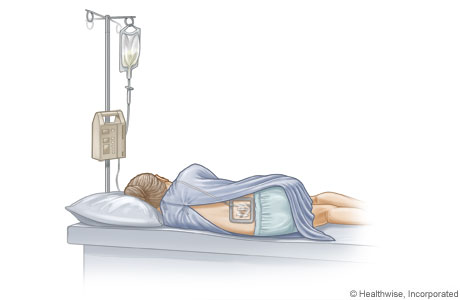childbirth: epidurals
treatment overview
an epidural for childbirth, called an "epidural" for short, is a tiny tube that puts pain medicine directly into the area in your back around your spinal cord. this area is called the epidural space.
an epidural can be used during childbirth to partly or fully numb the lower body. the amount of medicine you get will affect how numb you are. for labour and vaginal birth, a low dose of medicine is often used to decrease pain. but it often will allow enough feeling and muscle strength so that you can push during contractions. for a caesarean birth (c-section), a higher dose can be used to help block all feeling. the epidural allows you to be awake for the birth.
you probably won't be able to walk while you have an epidural.
for some women, the medicine may slow down labour. for others, it has no effect on the length of labour. in some cases, it may make labour go faster.
it often takes about 10 minutes for the pain medicine to start to work. it may take 20 to 30 minutes to get the full effect.
the medicine is not likely to affect your baby.
how it is done


epidural anesthesia involves putting a sterile guide needle and a small tube (epidural catheter) into the space around the spinal cord (epidural space). the epidural catheter is placed at or below the waist.
the guide needle is inserted and removed, while the catheter remains in place. the catheter is taped in place up the centre of your back and at the top of your shoulder.
medicine is injected into the catheter to numb your body below the insertion site. this will help relieve pain during labour and birth.
what to expect
the epidural catheter may be removed right after delivery. the numbness and muscle weakness in your legs will probably wear off within 2 hours after the epidural medicine is stopped. you may find that it's hard to urinate until all the medicine has worn off. your back may be sore. you may have a small bruise at the catheter site. this usually gets better in 1 or 2 days. in rare cases, an epidural may cause a headache that gets worse when you sit or stand. tell your doctor if you get a headache after your epidural. your doctor can treat it.
side effects
the most common side effect from an epidural is that it can lower the mother's blood pressure.
less common side effects may include a severe headache after delivery, problems urinating or walking after delivery, and a fever. a rare side effect is a seizure.
credits
current as of: june 24, 2023
author: healthwise staff
clinical review board
all healthwise education is reviewed by a team that includes physicians, nurses, advanced practitioners, registered dieticians, and other healthcare professionals.
current as of: june 24, 2023
author: healthwise staff
clinical review board
all healthwise education is reviewed by a team that includes physicians, nurses, advanced practitioners, registered dieticians, and other healthcare professionals.